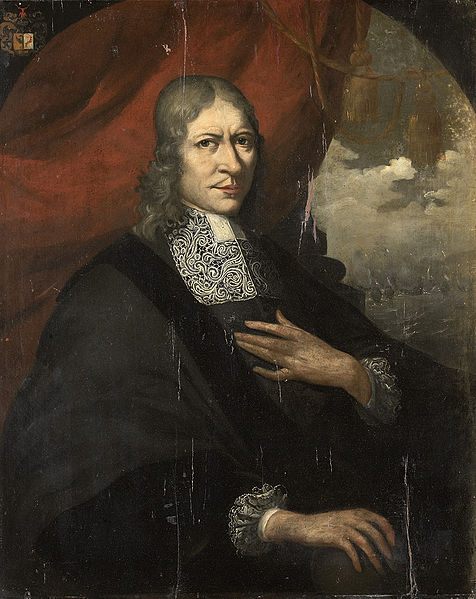<Back to Index>
- Economist Gustav von Schmoller, 1838
- Composer Louis Brassin, 1840
- Governor General of East Indies Rijcklof Volckerts van Goens, 1619
PAGE SPONSOR

Rijcklof Volckerts. van Goens (Rees , 24 June 1619 - Amsterdam , 14 November 1682) made a meteoric career in the VOC from 1659 to 1672 and was governor of Ceylon from 1678 - 1681 and Governor General of East Indies. Van Goens, mostly known as an excellent soldier, was also a diplomat and an expert on the Malay culture. His aggressive policies in Ceylon and the Malabar coast had limited success. Pieter van Dam was worried and upset about the costly military campaigns of Van Goens, that never produced much financial gains.
Rijcklof Goens was of East Friesian origin. His father Volckert Boukes (1572 - 1629) served in the States army and was stationed in Rees in Kleve. His uncle, born about 1580 in Emden, was already by 1624 in the East Indies and had persuaded his father to go into service with the VOC in Amsterdam and Volckert van Goens was appointed as commander of a company of soldiers. Accompanied by his parents Van Goens left in October 1628 on the ship Texel Buren and came on July 10, 1629 in Batavia. His parents died within one year and Rijklof was probably raised by his uncle in Batavia.
After a three year stay in Coromandel Coast on September 1, 1634 he became assistant to the warehouses in Batavia. In 1639 he became a merchant, in 1640 he married a widow, improving his social status. In 1642 he became a merchant. He went as an envoy from July to December 1644 at Palermo, in 1647 and 1648 to Jambi and Djohor. In 1649/50 he went to Siam as a diplomat and five times between 1648 and 1654 to Amangkurat I, the Susuhunan of Mataram, to secure the supply of rice and timber.
In 1649 he became a member of the Judicial Council, in 1650 appointed to the special council of the Indies, and in 1651 as head merchant, in 1653 he was president of the Orphan Chamber. On September 20, 1653 he was Commissioner and Commander in Ceylon and promoted to counsel by Joan Maetsuycker. The truce with Portugal was not renewed and gaining two victories in 1654 he captured five Portuguese ships, which were burned. In January 1655 he returned to Holland as admiral of the fleet. In his report to the States General he laid emphasis on the conquest of Ceylon. He found that the island had a better location than Batavia. In its Java Genocide Reise he described the despotic government of Mataram, the important position of women at court, the tropical landscape and the inscrutability of the Javanese.
On his return to India he was for two months a commissioner of the Cape of Good Hope, where Jan van Riebeeck was governor. In September he went to Ceylon and captured Colombo, Tuticorin, Jaffna, Nagapattinam by the Portuguese. From 1659 - 1672 he was governor of Ceylon, a post he relinquished in 1675 to his son. He buried his first two wives in the Wolvendaal Church in Colombo. In December 1661, he won with 4,000 men Quilon and besieged the Portuguese in the following days at Cranganore. Van Goens was welcomed by the samorijn Malabar and other princes, who also wanted to get rid of the Portuguese. In 1662 he made an attempt at Kochi (India), the center of the spice trade. His hat was shot and Henry Rheede was captured. Because of the monsoon rain he had to retreat. At the end of the year (November) he renewed his attempts. On January 8, 1663, he conquered the city with a bombardment. In 1672 he fought a battle with the British and French fleets in Ceylon, Malabar and the Coromandel Coast . He faced a guerrilla war on the island. In 1677 Henry Rheede Van Goens wrote that the plans were doomed to failure. In early 1679 he resigned, but it took two years before he could leave (November 1681). Van Goens died in Amsterdam.